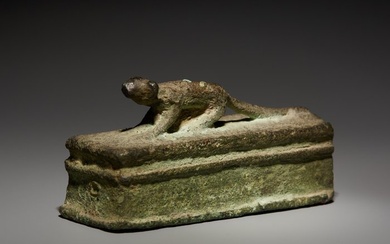Sarcophagus; Egypt, late period 664-332 B.C. Polychrome
Sarcophagus; Egypt, Lower Egypt 664-332 BC.
Wood, stucco and pigments.
Provenance: Private collection, Spain. Acquired in London around 1980.
Good general state of preservation. No major faults.
Measurements: 157 x 39 cm.
Complete sarcophagus that conserves both the front and the obverse. The piece is highly decorated throughout. In the lower area, in the form of a base, a delimited cartouche can be seen, inside of which some of the hieroglyphic characters can be seen. This way of representing it, inscribed inside a line that surrounds it, probably indicates that it is the name of the deceased person destined for this sarcophagus. The decoration extends to the upper area where a jackal can be seen, representing Anubis, the god of death, patron of embalming, and above the figure of the scarab beetle, which represents the protection of the deceased and the concept of eternity, since in ancient Egypt these animals were believed to resurrect. Finally, the upper part of the sarcophagus is dedicated to the headdress and the face of the deceased, as is customary in sarcophagi.
In Ancient Egypt, the sarcophagus was associated with embalming and mummification rituals, designed to bring the deceased to eternal life. During the Middle Kingdom the custom arose of placing masks made of linen and a paste similar to cardboard over the face and shoulders of the deceased. This led to the appearance of the first anthropomorphic sarcophagi, coffins in human form, almost always made of wood (examples for the pharaohs would be made of much richer materials, such as gold combined with inlays of different stones). They would be ornamented with painted scenes and texts, with funerary symbolism, and accompanied by a wide variety of amulets. Generally speaking, however, the sarcophagus of the New Empire, especially the royal sarcophagus, will be characterised by its rectangular shape, in imitation of the earliest examples of the New Empire. However, the anthropomorphic type of coffin would continue over the centuries until the end of the Pharaonic world, with some variations (especially during the years of Roman rule in the area).
The disintegration of the New Empire ushered in the long period known as the Late Period (7th-4th centuries BC), during which the Egyptian state was progressively weakened, before finally being conquered by Alexander the Great in 332 BC and becoming part of the Hellenistic world. The Ptolemaic period lasted until the Roman conquest in 30 BC. This long period of Roman domination, although it lasted until the Muslim conquest in 638 (from 395, after the death of Theodosius, Egypt became part of the Eastern Roman Empire), included a first period in which the ancient Egyptian structures still dominated, which lasted until the 4th century, when paganism was definitively banned.
Estimate
Time, Location
Auction House
Sarcophagus; Egypt, Lower Egypt 664-332 BC.
Wood, stucco and pigments.
Provenance: Private collection, Spain. Acquired in London around 1980.
Good general state of preservation. No major faults.
Measurements: 157 x 39 cm.
Complete sarcophagus that conserves both the front and the obverse. The piece is highly decorated throughout. In the lower area, in the form of a base, a delimited cartouche can be seen, inside of which some of the hieroglyphic characters can be seen. This way of representing it, inscribed inside a line that surrounds it, probably indicates that it is the name of the deceased person destined for this sarcophagus. The decoration extends to the upper area where a jackal can be seen, representing Anubis, the god of death, patron of embalming, and above the figure of the scarab beetle, which represents the protection of the deceased and the concept of eternity, since in ancient Egypt these animals were believed to resurrect. Finally, the upper part of the sarcophagus is dedicated to the headdress and the face of the deceased, as is customary in sarcophagi.
In Ancient Egypt, the sarcophagus was associated with embalming and mummification rituals, designed to bring the deceased to eternal life. During the Middle Kingdom the custom arose of placing masks made of linen and a paste similar to cardboard over the face and shoulders of the deceased. This led to the appearance of the first anthropomorphic sarcophagi, coffins in human form, almost always made of wood (examples for the pharaohs would be made of much richer materials, such as gold combined with inlays of different stones). They would be ornamented with painted scenes and texts, with funerary symbolism, and accompanied by a wide variety of amulets. Generally speaking, however, the sarcophagus of the New Empire, especially the royal sarcophagus, will be characterised by its rectangular shape, in imitation of the earliest examples of the New Empire. However, the anthropomorphic type of coffin would continue over the centuries until the end of the Pharaonic world, with some variations (especially during the years of Roman rule in the area).
The disintegration of the New Empire ushered in the long period known as the Late Period (7th-4th centuries BC), during which the Egyptian state was progressively weakened, before finally being conquered by Alexander the Great in 332 BC and becoming part of the Hellenistic world. The Ptolemaic period lasted until the Roman conquest in 30 BC. This long period of Roman domination, although it lasted until the Muslim conquest in 638 (from 395, after the death of Theodosius, Egypt became part of the Eastern Roman Empire), included a first period in which the ancient Egyptian structures still dominated, which lasted until the 4th century, when paganism was definitively banned.




